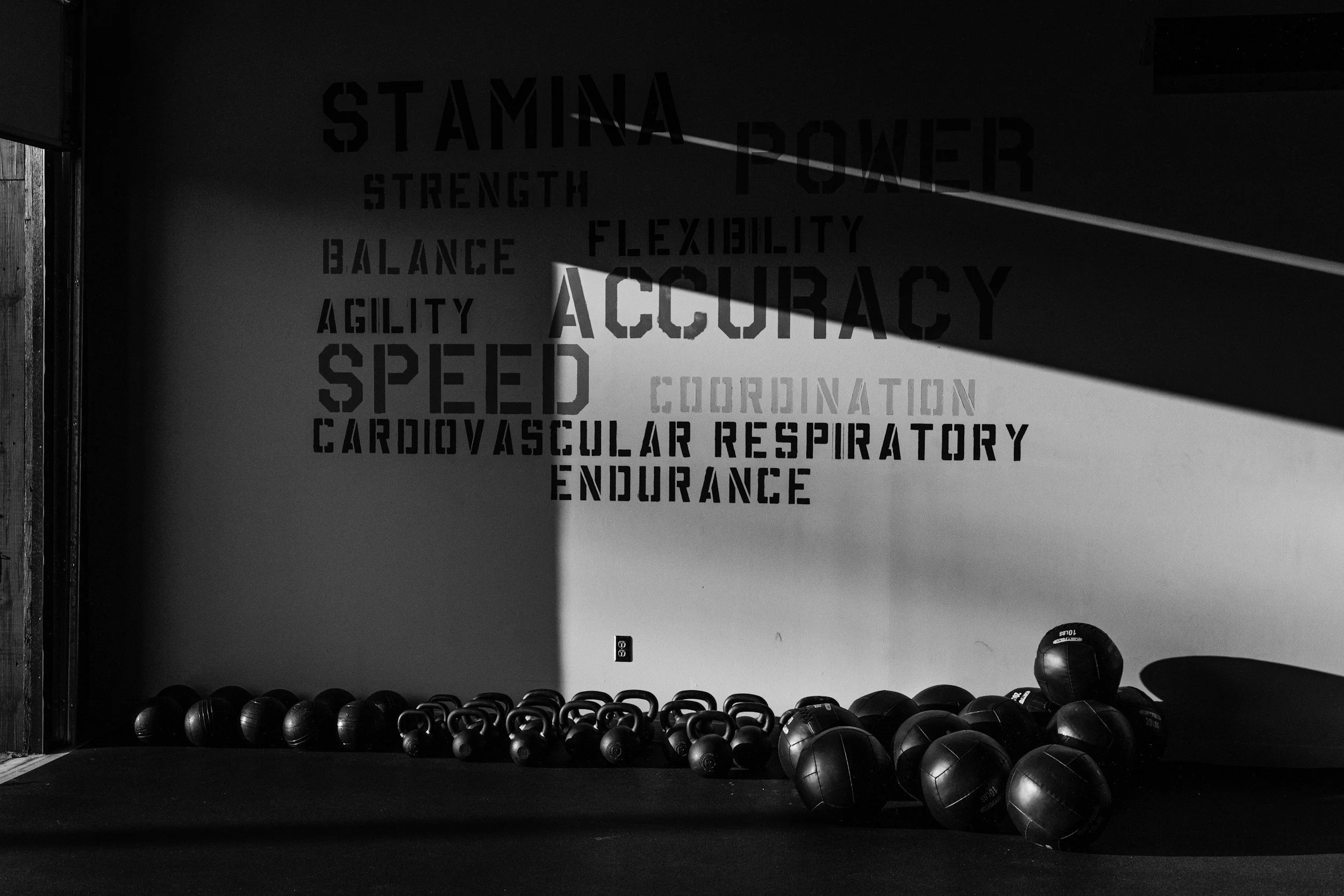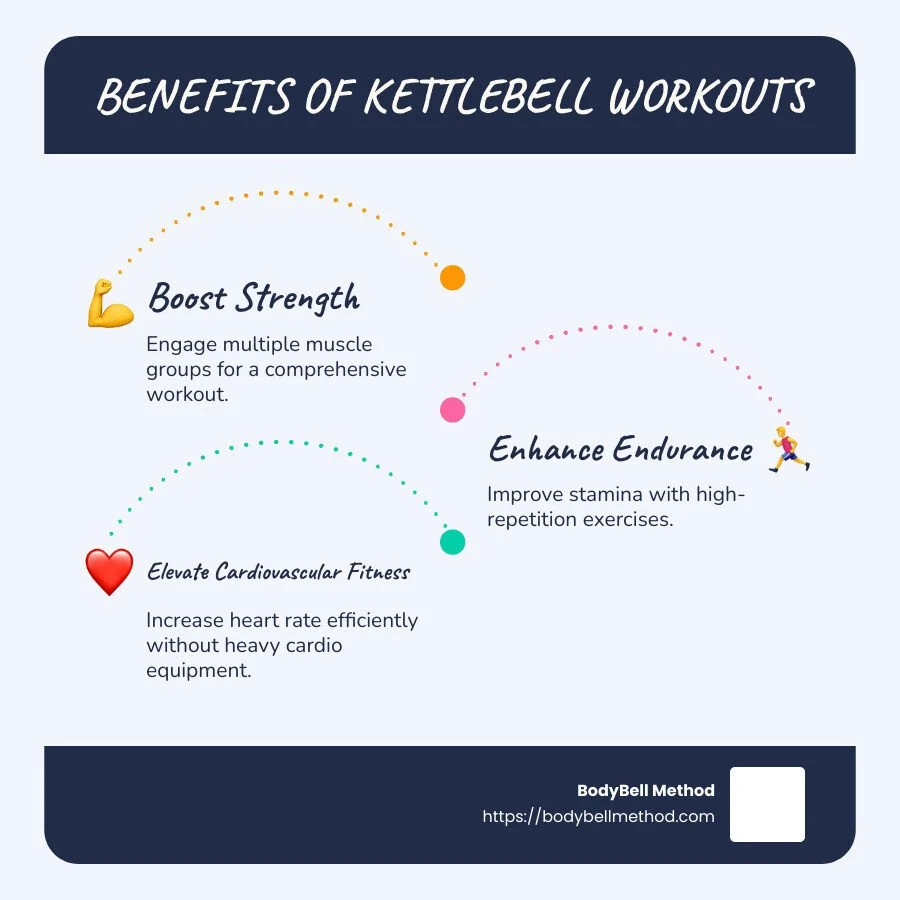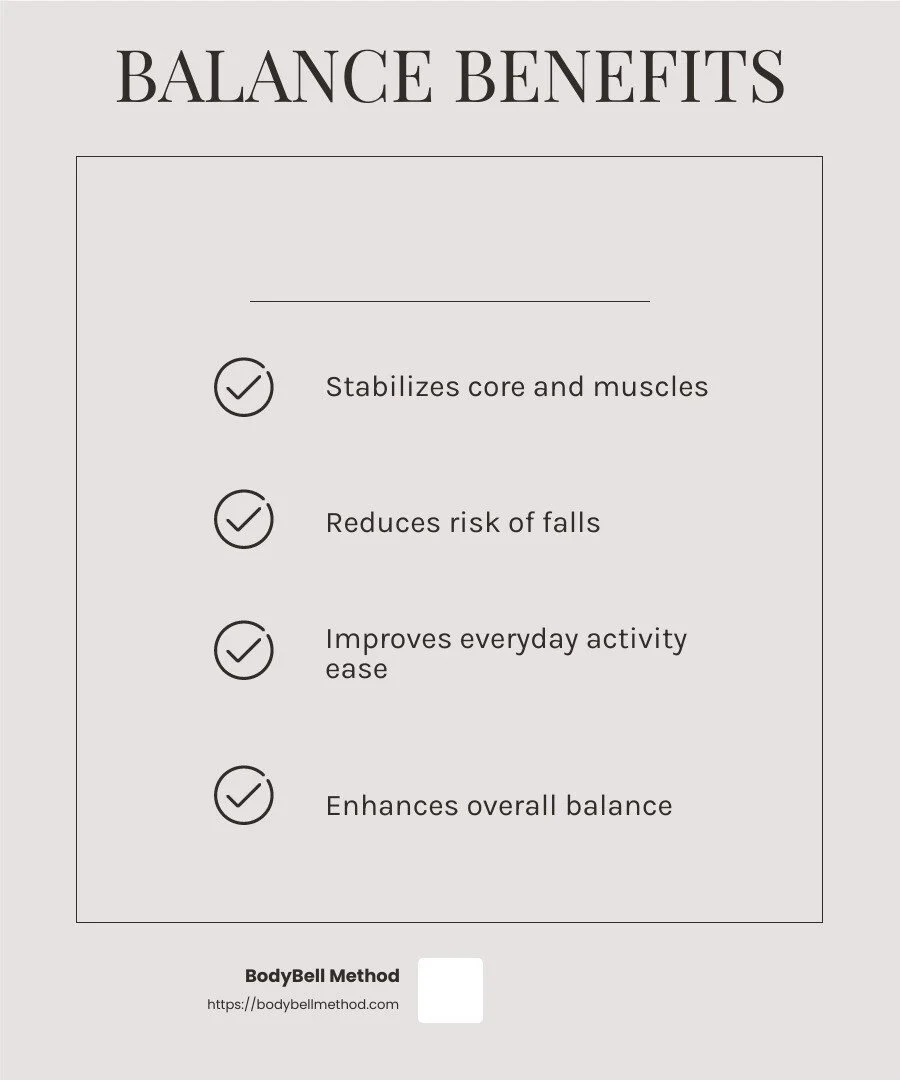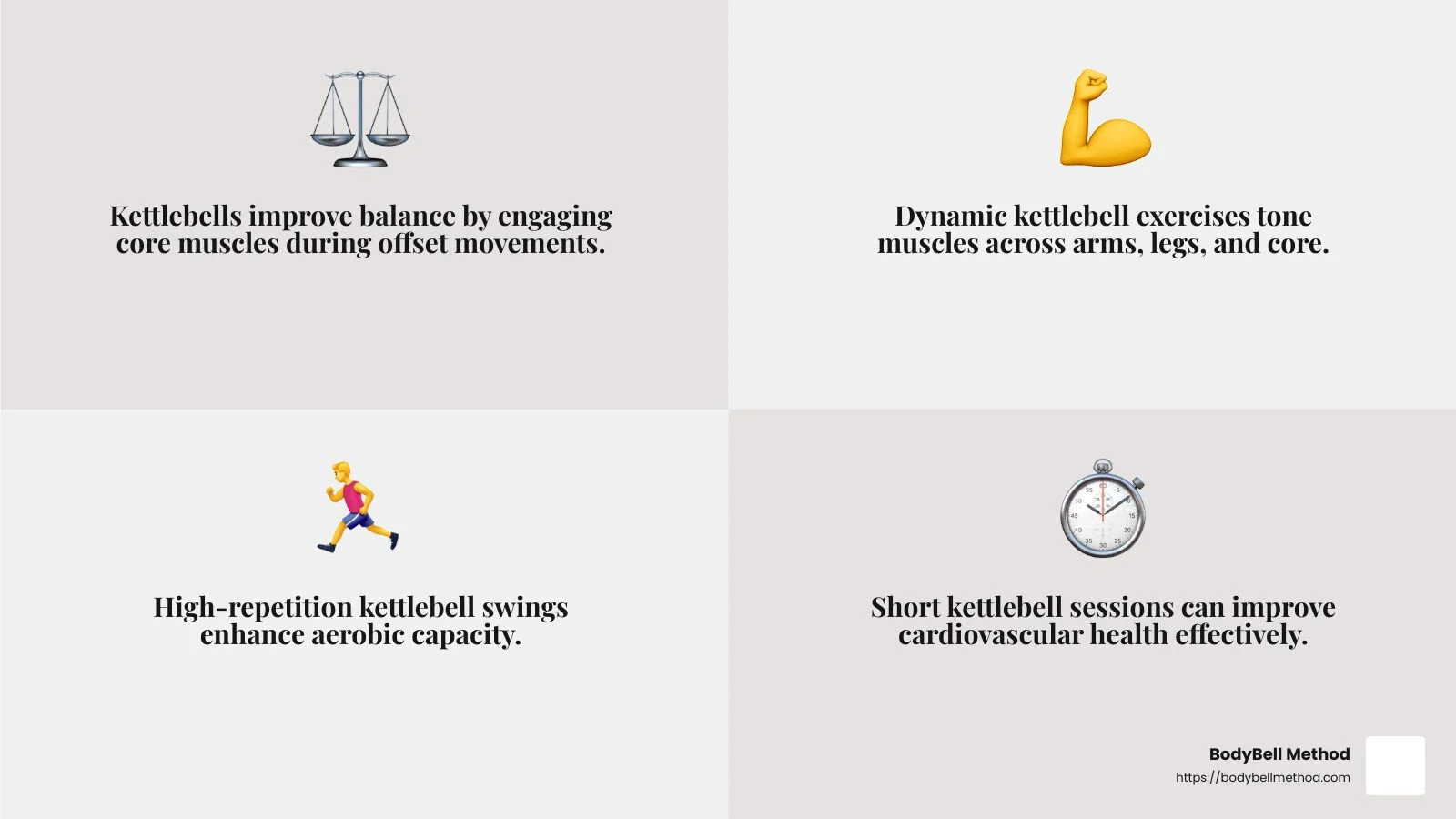The Ultimate Guide to Full Body Kettlebell Workouts
When it comes to achieving a well-rounded fitness routine, a full body kettlebell workout is a powerhouse choice for strength building, endurance, and cardiovascular fitness. With just a single piece of equipment, you can:
Boost Strength: Target various muscle groups for a comprehensive workout.
Improve Endurance: Improve stamina with high-repetition kettlebell exercises.
Lift Cardiovascular Fitness: Increase heart rate efficiently without heavy cardio equipment.
Kettlebells are versatile and effective, making them a go-to for those short on time but eager for results.
As a fitness and martial arts expert with over 40 years of experience, I, Phil Ross, have harnessed the power of kettlebells through my innovative BodyBell Method®. This expertise in full body kettlebell workouts is designed to improve strength, endurance, and cardiovascular health, helping you maximize workout efficiency and client results.
Benefits of Full Body Kettlebell Workouts
A full body kettlebell workout offers a range of benefits that go beyond just building muscle. Let's explore how these workouts can improve your overall fitness.
Balance Improvement
Kettlebells are unique because they have an offset center of gravity. This means your body has to work harder to stabilize during exercises. As you perform movements like the kettlebell swing or renegade row, your core and stabilizing muscles engage more intensely. This helps improve your balance, making everyday activities easier and reducing the risk of falls.
Kettlebell training strengthens your core, improving your balance and stability.
Muscle Tone
Kettlebell workouts are excellent for muscle toning. Unlike traditional weights, kettlebells allow for dynamic movements that engage multiple muscle groups simultaneously. This results in more defined muscles. Exercises like the goblet squat and kettlebell clean and press are particularly effective in targeting and toning muscles across your arms, legs, and core.
Aerobic Capacity
While kettlebells are known for strength training, they also significantly boost aerobic capacity. High-repetition exercises, such as kettlebell swings, lift your heart rate, providing a cardio workout that improves your cardiovascular health. This makes kettlebell workouts a great option for those looking to improve their aerobic fitness without spending hours on a treadmill.
Incorporating these workouts into your routine can lead to impressive gains in balance, muscle tone, and aerobic capacity. Whether you're a beginner or a seasoned athlete, kettlebells offer a versatile and effective way to achieve your fitness goals.
Essential Kettlebell Exercises for a Full Body Workout
A full body kettlebell workout can transform your fitness routine by engaging multiple muscle groups. Let's explore five essential exercises that form the backbone of these workouts.
Kettlebell Swing
The kettlebell swing is a dynamic exercise that targets your legs, glutes, back, and shoulders. It's a powerhouse move for building strength and endurance. The swing's explosive motion helps spike your heart rate, offering both cardio and strength benefits. Remember to keep your swings at shoulder height to optimize strength and mobility.
Goblet Squat
The goblet squat is a staple for leg and core strength. Holding the kettlebell close to your chest, you perform a deep squat, which engages your quads, glutes, and core. This exercise is excellent for improving lower body strength and enhancing flexibility. Focus on keeping your chest up and weight in your heels for the best results.
Kettlebell Deadlift
The kettlebell deadlift is perfect for targeting the glutes, hamstrings, and lower back. By hinging at the hips and maintaining a neutral spine, you lift the kettlebell from the ground, engaging your posterior chain. This exercise is crucial for building overall body strength and improving posture. Ensure your back stays straight throughout the movement.
Kettlebell Clean and Press
This compound movement combines a clean with an overhead press, working your entire body. It targets the core, shoulders, and arms while also engaging the legs and glutes. The clean and press is ideal for developing explosive power and upper body strength. Keep your core tight and press the kettlebell overhead smoothly.
Kettlebell Renegade Row
The renegade row challenges your core and upper body strength. Starting in a plank position with a kettlebell in each hand, you row one kettlebell to your hip, alternating sides. This exercise works the back, shoulders, and arms while demanding core stability. Maintain a straight body line and avoid twisting your hips.
These exercises are fundamental to any full body kettlebell workout, offering a balanced approach to strength, endurance, and cardiovascular fitness. By incorporating these movements, you can efficiently target every major muscle group and boost your overall fitness.
How to Get Started with Kettlebell Training
Starting a full body kettlebell workout can be exciting and rewarding. Here’s how to begin your journey safely and effectively.
Beginner Tips
Start Light: If you're new to kettlebells, begin with lighter weights to perfect your form. Women might start with 8-15 pounds, while men might choose 15-25 pounds, according to the American Council of Exercise.
Focus on Form: Proper form is crucial to avoid injuries and maximize benefits. For example, keep your back straight during swings and deadlifts.
Warm Up: Always begin with a 5-10 minute warm-up. Light aerobic activities or dynamic stretches can prepare your muscles and joints.
Weight Selection
Choosing the right kettlebell weight is key. A weight that's too light won't challenge you, while one that's too heavy can lead to poor form and injury.
Beginners: Start light to learn movements safely. Focus on mastering the basics before increasing weight.
Intermediate to Advanced: As you progress, gradually increase the weight. Women might move to 18 pounds, and men to 35 pounds, as suggested by ACE.
Form Perfection
Perfecting your form is essential for effective training and injury prevention. Here are some form tips for key exercises:
Kettlebell Swing: Keep your core engaged and maintain a neutral spine. Swing to shoulder height for optimal results.
Goblet Squat: Hold the kettlebell close to your chest. Keep your chest up and weight in your heels.
Deadlift: Hinge at the hips, not the waist. Keep your back straight and shoulders back.
Clean and Press: Use a smooth motion. Engage your core and press overhead without arching your back.
Renegade Row: Maintain a straight line from head to heels. Avoid twisting your hips during the row.
By following these tips, you’ll set a strong foundation for your kettlebell training. Consistency is key, and as you improve, you can explore more advanced techniques and routines.
Full Body Kettlebell Workout Routine
Ready to dive into a full body kettlebell workout? This 20-minute routine is efficient and effective, perfect for all fitness levels.
20-Minute Workout
This workout, inspired by fitness coach Obi Vincent, is designed to improve core stability and replicate real-life movements, enhancing functional fitness. You’ll need just a couple of kettlebells and a timer. Here's what you'll do:
Goblet Squat: 2 sets of 8 reps
Single-Arm Overhead Press: 2 sets of 6 reps per side
Overhead Reverse Lunge: 2 sets of 8 reps per side
Kettlebell Swing: 2 sets of 15 reps
Single-Arm Row: 2 sets of 6 reps per side
Floor Press: 2 sets of 8 reps per side
Biceps Curl: 2 sets of 10 reps per side
Superset Structure
In this workout, you'll perform exercises in a superset format. This means you’ll do one set of an exercise, then immediately move to the next exercise without rest. This structure helps keep your heart rate up, providing cardiovascular benefits while building strength.
For example, you might pair the goblet squat with the single-arm overhead press. Complete both sets back-to-back, then rest before moving on to the next pair of exercises.
Exercise Pacing
Pacing is key in a kettlebell workout. Focus on maintaining good form rather than rushing through reps.
Controlled Movements: When performing strength moves, prioritize slow, controlled motions to engage muscles fully.
Explosive Power: For power exercises, like the kettlebell swing, use explosive movements to maximize the benefits.
Aim to complete each exercise with precision. Short breaks between exercises help keep the workout intense and effective.
By following this routine, you'll enjoy a total-body sweat session that boosts strength, endurance, and cardiovascular fitness.
Next, we'll address some frequently asked questions about full body kettlebell workouts.
Frequently Asked Questions about Full Body Kettlebell Workouts
Can you do a full-body workout with just kettlebells?
Absolutely! A full body kettlebell workout can engage every major muscle group. The unique design of kettlebells allows for versatile exercises that mimic everyday movements. For example, a kettlebell swing targets your lower back, glutes, and hamstrings, while a goblet squat focuses on your quads and inner thighs. Exercises like the kettlebell clean and press and renegade row engage both upper and lower body muscles, making it possible to train your entire body with just one piece of equipment.
How often should you do a full-body kettlebell workout?
When it comes to frequency, balance is key. While kettlebell workouts are effective, it's important not to overdo it. Aim for 3-4 sessions per week, allowing at least one rest day in between to let your muscles recover. This helps prevent overtraining and reduces the risk of injury. If you're new to kettlebell training, start with lighter weights and gradually increase as you build strength and confidence. It's crucial to listen to your body and adjust your routine based on how you feel.
Can you get fit with only a kettlebell?
Yes, you can achieve fitness goals with just a kettlebell. Kettlebell training can improve strength, cardiovascular health, and muscle tone. The key is to select the right weight and vary your workouts to challenge your body. As you progress, increase the weight or intensity to promote muscle growth and endurance. Fitness isn't just about the workouts. Nutrition and rest play significant roles in achieving your goals. With dedication and consistency, kettlebells can be a powerful tool in your fitness journey.
Next, we'll explore the BodyBell Method and how it can improve your fitness routine.
Conclusion
The BodyBell Method is more than just a workout plan; it's a comprehensive approach to fitness that empowers both trainers and enthusiasts. By integrating biomechanics and proven techniques, we offer a modern, functional approach to kettlebell training that is recognized by leading fitness organizations.
Our NASM- and ACE-accredited certifications provide a well-rounded education in kettlebell training, calisthenics, and dynamic tension. These certifications equip trainers with the skills needed to improve client outcomes, advance their careers, and stay competitive in a rapidly evolving market. With our cutting-edge curriculum and hands-on training, trainers learn to build strength, mobility, and endurance for clients of all fitness levels.
The BodyBell Method is designed to deliver improved performance through structured and practical training. Our focus on functional fitness ensures that trainers can help clients achieve their goals, whether it's increasing muscle tone, boosting cardiovascular health, or enhancing overall endurance. By mastering the basics and progressing to more advanced movements, trainers can guide clients through effective full body kettlebell workouts that are both challenging and rewarding.
If you're ready to take your fitness journey to the next level, explore our BodyBell Method and find how our innovative system can transform your approach to training.




